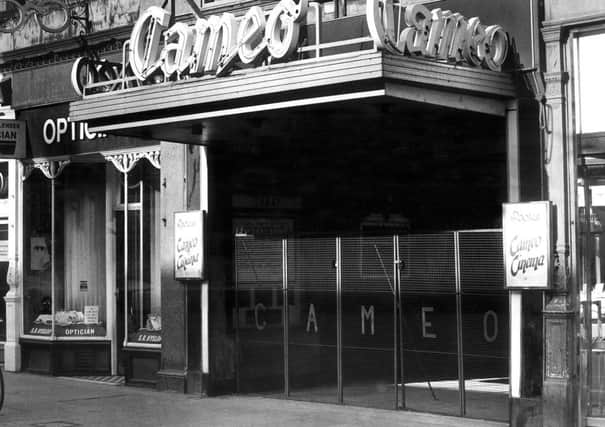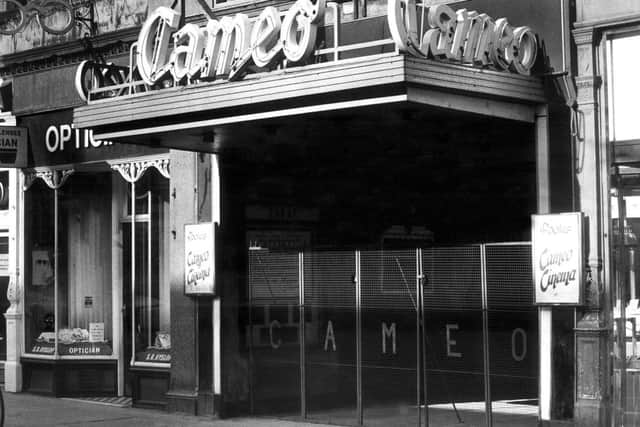Cameo cinema celebrates 100th birthday


When the doors opened to a picture house in Home Street 100 years ago tomorrow, the curtain went up on a world of romance and high drama, one in which film fans could be scared out of their seats, quietly weep or laugh uproariously as the magic of moving pictures took them to places they could barely have dreamed of.
Then known as the King’s, it would be reborn as the Cameo. And apart from that name change and a few vital modern touches – including today’s three dimensional screen showing images which no doubt would have left the pre-First World War audiences bewildered – not much has really changed since those early film fans settled down beneath the ornate plaster ceiling for a couple of hours of escapism.
Advertisement
Hide AdAdvertisement
Hide AdThe Tollcross cinema, one of the oldest picture houses still operating in Scotland, will celebrate its centenary tomorrow when invited guests will gather to watch a special preview screening of Inside Llewyn Davis, a Coen brothers’ film about a New York folk singer starring, among others, Carey Mulligan and Justin Timberlake.


The birthday party film casts a backward glance to the folk music movement of the early Sixties. Yet back in the real world, by that same Swingin’ Sixties era the Tollcross picture house had already well and truly staked her place in the hearts of city film-goers for half a century.
Only a short blip in the Eighties, when modern technology in the form of home videos plunged many cinemas into darkness, and a post-war spell in the Forties have interrupted screenings.
Among the Cameo’s most avid fans is Genni Poole, whose father, Jim, took over the King’s in 1947, and reopened it as the Cameo. He stressed its arthouse credentials in an advert which appeared in the Scotsman in March 1949, announcing it as “A cinema for the discerning” showing “week by week carefully chosen films of artistic merit screened in an atmosphere that sets a new standard in cinema decoration and comfort”.
Advertisement
Hide AdAdvertisement
Hide AdIt’s a pledge which, according to Genni – who grew up playing in the empty cinema while her dad organised behind-the-scenes business – is just as relevant today.
“The Cameo is not just a box where people go and watch a movie and get all the special effects but could be sitting in any place in the country,” she says.
“The Cameo is actually a cinema with a beating heart. It’s an experience to go and watch the film in the Cameo.
“In the Cameo you know you are in a historic building and in a special, unique place. I look on her as a very grand old lady.”
Advertisement
Hide AdAdvertisement
Hide AdMoving pictures were first screened at the venue on January 8, 1914, when film-goers arrived to find 673 seats, a revolutionary mirrored screen – the first of its kind in the country – and a live orchestra in place to provide the musical accompaniment to the silent films.
Many would already have witnessed the birth of moving pictures brought to them by Genni’s grandfather, John Poole, who with his family ran dioramas – mobile theatres showing often historically themed pictures with images which changed depending on how they were lit.
By the time her father took over the then King’s in 1947, the Poole family was running the Roxy in Gorgie, the Synod Hall and other cinemas across the country.
Running the cinema was a dream conceived by Jim in the maelstrom of the Middle East where he served during the Second World War with a remit as chief entertainment officer for the troops.
Advertisement
Hide AdAdvertisement
Hide Ad“He put on film shows and had to source the movies from wherever he could,” Genni explains. “He showed many foreign films, many of which had not just one lot of subtitles but many subtitles in different languages. He gained a huge amount of experience and love for foreign films and he brought that back to Edinburgh.”
He returned to find the King’s in disrepair as the impact of war and rationing took its toll on leisurely follies like the cinema – and an opportunity to share his love of foreign and art movies.
Once in charge he opted not to rip out her ornate interior for something more practical and instead spent the next two years battling to restore the remarkable interior to glory.
“My father would tell stories about how the water dripped through the roof and they had to place jam jars at strategic places,” says Genni with a laugh.
Advertisement
Hide AdAdvertisement
Hide Ad